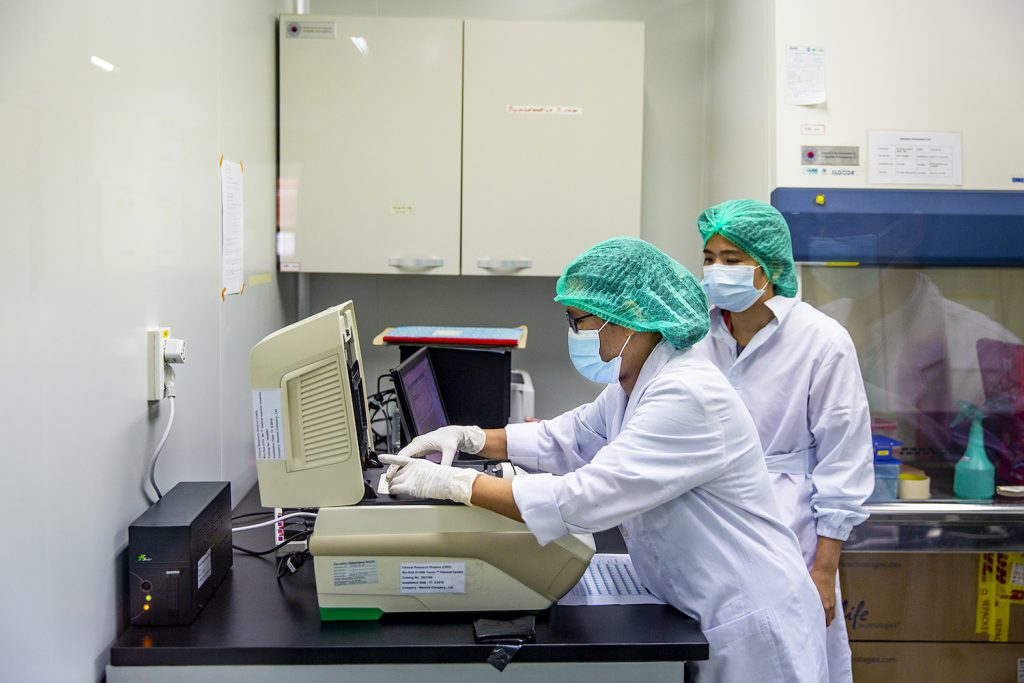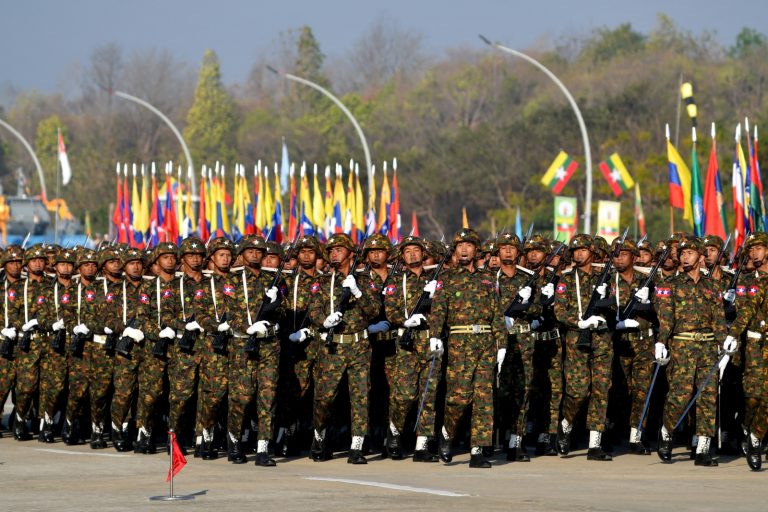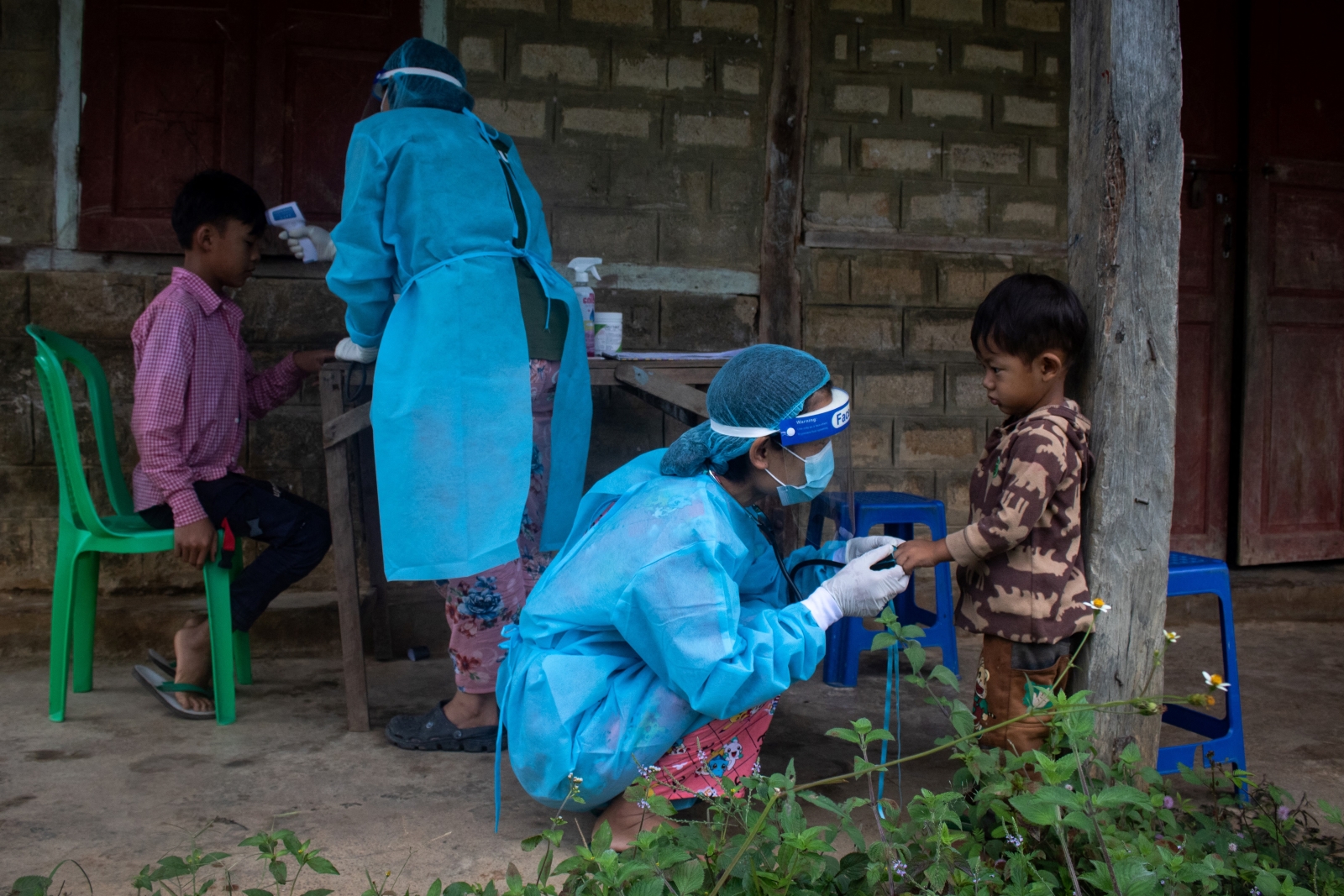As people crowded onto streets to chant down military rule, the Civil Disobedience Movement quietly dismantled the junta’s ability to test, treat, and inoculate against the coronavirus; many call that a success.
By FRONTIER
Just after the military seized power from the democratically-elected government in the early hours of February 1, public health workers found themselves in an agonising ethical dilemma: walk out from their hospitals, clinics and labs in the midst of a global pandemic to join a national strike against military rule, or continue working under what they saw as an illegitimate regime that would inevitably eliminate the last decade’s gains in public health.
In the end, tens of thousands of them chose the former.
While government health workers have been praised for their vanguard role in launching the growing Civil Disobedience Movement, their decision to strike has had serious ramifications for the country’s response to the COVID-19 pandemic.
The largest anti-military rallies brought hundreds of thousands of people onto densely packed streets throughout February, and though most wore masks, they huddled close together while chanting slogans and singing revolutionary songs – a recipe for spreading the coronavirus, many experts worry. Meanwhile, testing to identify the virus’ spread has all but collapsed. And even if cases could be identified, most hospitals and quarantine centres capable of treating or isolating patients have shuttered, the military regime’s efforts to strong-arm staff back to work having mostly failed.
Hope flashed brightly, if briefly, when vaccines began to arrive from India in late January, just days before the coup. By March 11, Myanmar had acquired 3.5 million doses of Covishield, the Serum Institute of India-made vaccine based on Oxford-AstraZeneca’s, with another 3 million due before June, Dr Khin Khin Gyi, director of emerging infectious diseases at the Ministry of Health and Sports’ Central Epidemiology Unit, told Frontier at the time. But Dr Htar Htar Lin, who was the director of the nation’s immunisation programme, has also joined the CDM. She’s since gone into hiding, dogged now by corruption allegations from the regime, and the immunisation programme has also collapsed, with frontline health workers across the country refusing inoculation in solidarity with Htar Htar Lin and until the military restores democracy.
Amid the public, too, the threat of a global pandemic seems to pale in comparison to that of continued military rule. As the junta’s soldiers and police continue to gun down more civilians each day, most have put the coronavirus behind them for now.
A resident of North Okkalapa, a Yangon township with a historically high COVID-19 case count, told Frontier in February that the disease is just not a priority there right now.
“The coup government is more dangerous than COVID-19,” he said.
Anti-vaxxers
Daw Thet Thet Thein, a 50-year-old Yangon General Hospital nurse, was the first in the country to receive a COVID-19 jab, on January 27 – the day the country’s more than 103,000 government health workers began receiving their first of two doses of Covishield.
Their second injection was scheduled for late February; the SII says the vaccine is most effective if this final dose is taken between four and 12 weeks after the first.
Since the coup, however, more than 60,000 of these health workers have joined the CDM and are boycotting their second jabs until the military regime steps down, according to estimates from one ministry source. Many of them fear that if they return to hospitals and clinics for the second shot they’ll will be forced to give up the CDM and return to work.
Among them is Htar Htar Lin, the former director of Myanmar’s Expanded Program on Immunization, which ran the country’s COVID-19 vaccine rollout.
Before the coup, the health ministry had said it planned to vaccinate 40 percent of the country by the end of the year – 20pc for free through COVAX, an international programme that helps low-income countries acquire vaccines, and the other half through deals with producers in other countries, such as India.
“I may escape or I may be detained by the military by the time you read this, but I will never surrender my country or our children’s futures”
Dr Htar Htar Lin, former director of Myanmar’s Expanded Program on Immunization
After Htar Htar Lin joined the CDM, she wrote to colleagues in a private Signal group on February 16 saying that the junta had accused her of corruption in vaccine procurement, and of misusing funds donated to the immunisation programme. She denied the allegations, adding that police had searched her home and that she’d gone into hiding.
“They posted on Facebook on February 18 that the EPI director was running away with billions of kyat, with a photo of me, seven days after I resigned [to join CDM],” she wrote in the message, which was later leaked to the media and which Frontier confirmed as authentic with multiple health ministry sources.
“I may escape or I may be detained by the military by the time you read this, but I will never surrender my country or our children’s futures”, she added.
Since her defection, most members of the state and regional EPI teams critical to the country’s vaccine rollout have also joined the CDM.
“Dr Htar Htar Lin and her whole EPI team are participating in the CDM, refusing to carry out the COVID vaccination plan on behalf of the military government, so the junta wants to make an example of her,” one ministry source told Frontier. “She is now in a position of great risk because of the military’s accusations.”
A senior official with the Department of Medical Research in Yangon told Frontier that healthcare professionals’ refusal of their second jab is also a show of solidarity with the persecuted immunisation programme director.
“We expect to be vaccinated when the elected civilian government returns to power,” she said.
The boycotts and mass defections have thoroughly sabotaged the military regime’s promise on the day of the coup to prioritise overcoming the pandemic, and it has virtually frozen progress on vaccinations.
Not everyone is in revolt, however. Khin Kyin Gyi, who has directed the health ministry’s infectious disease programme since before the coup, has decided to continue in her role and work with the regime, which she insists continues to is vaccinate people.
“Health and politics should not mix in the current situation, and nobody should refuse to be vaccinated,” she told Frontier on February 24, adding that the death toll from COVID-19 continues to rise around the world.
She said vaccinating medical staff may be delayed, but the first doses have not gone to waste – yet.
“Health and politics should not mix in the current situation, and nobody should refuse to be vaccinated.”
Dr Khin Khin Gyi, Central Epidemiology Unit director of infectious disease
“Research in the UK has found that the second shot can be administered between one and three months after the first,” she said.
She’s not completely alone in her stance.
“The vaccines were not bought by the military junta, they were acquired by Daw Aung San Suu Kyi’s government,” said an official at Yangon General Hospital who spoke on condition of anonymity.
But with hopes even before the coup for less than half the population to have been vaccinated by year’s end, identifying, isolating and treating COVID-19 cases have always been central to any response. The CDM has destroyed the junta’s ability to do any of these effectively.
‘The reality of the situation’
At the time of the coup, the country had reported 140,927 COVID-19 cases, with 3,160 deaths and 126,384 patients discharged from government hospitals. Cumulative figures from the health ministry show that 2,422,939 people had been tested for the virus by then, and that the infection rate was declining through January, by the end of which the number of daily positive tests fell below 3pc.
Subsequent ministry figures show that just 1,892 new cases of COVID-19 were detected throughout the country between February 1 and March 21, of whom 266 patients died and 6,439 were discharged.
Public health experts universally concede that such low figures are no sign of a waning crisis, but evidence of the collapse of Myanmar’s ability to test for and detect cases. We no longer have an any idea what is happening with the virus in the country, they say.
“The cases we’re finding through testing are far fewer now than before [February 1], but these case numbers that the ministry is announcing simply cannot accurately reflect the reality of the situation,” Khin Khin Gyi said.
Before February 3, the Ministry of Health and Sports released fairly detailed, daily reports on COVID-19 numbers throughout the country, which included information on the geographical spread of cases. After February 3, however, much of this reporting has ceased. The state-owned Myawaddy TV still airs a daily report on its 8pm broadcast, though it is far less detailed, including just daily tests and confirmed case counts.
“It is not clear where infections are occurring, so it is difficult to say in which states and regions outbreaks might be happening,” said another senior public health expert who requested anonymity.
Figures released by the ministry at 8pm on March 21 showed just six people had tested positive from 1,070 swab taken and zero fatalities that day.
Those figures brought the cumulative total of COVID-19 cases to 142,246, with 3,404 deaths.
“…these case numbers that the ministry is announcing simply cannot accurately reflect the reality of the situation.”
Dr Khin Khin Gyi
Khin Khin Gyi said on March 10 that, before February 1, the health ministry was testing nearly 30,000 swab samples a day, but that number has fallen to about 1,700 since.
Testing had previously been done at public health laboratories, hospitals and clinics across the country, but she said they’re now only being tested at military hospitals and just a few public hospitals in some state regions, as well as at public health laboratories in Nay Pyi Taw and in the Shan and Mon state capitals, Taunggyi and Mawlamyine.
“We still need to expand coverage to include the whole country,” said Khin Khin Gyi.
Another ministry official asking for anonymity said most public health labs have shut because of staff defections to the CDM, and that testing at labs and hospitals in Mandalay, Taunggyi, Mawlamyine and Muse, in northern Shan State, are all on the verge of collapsing as well.
Multiple calls by Frontier to Dr Htay Htay Tin, the deputy director general of the National Health Laboratory, went unanswered.
More dangerous than disease
Even with ample testing and detection, staff walk-offs have devastated the government’s capacity to treat and isolate positive cases and their contacts. In Yangon Region, for example, the number of non-military medical facilities treating COVID-19 has declined dramatically since February 1, from 13 to three, medical sources say.
Before the coup, coronavirus patients were being treated at seven government hospitals in the region, including Yangon General Hospital and the Waibargi Infectious Diseases Hospital, plus another six purpose-built treatment centres throughout the city, including the Phaunggyi treatment centre in Hlegu Township and the Ayeyarwady treatment centre in Thingangyun Township.
A volunteer doctor with the community fever clinic network in Yangon, who declined to give his name, told Frontier on March 11 that treatment is now available only at the Phaunggyi facility, at two private hospitals – Pun Hlaing Siloam in Hlaing Tharyar Township and Ar Yu International in Tarmwe Township – and at military hospitals.
“When a patient contacts us, we connect them to Pun Hlaing Hospital – if they can afford it. Otherwise we connect them to the Phaunggyi centre or to the military hospitals,” the volunteer doctor said.
The Phaungyyi facility closed on February 12 because so few cases were being detected after the coup, but was reopened on February 18 and is manned by 41 military healthcare personnel and about 20 volunteers, according to a Yangon Region Health Department official who asked for anonymity.
An official at YGH, which was previously capable of treating about 1,000 COVID-19 patients at a time, said it stopped providing treatment on February 7.
Pun Hlaing Siloam Hospital, which started testing for and treating COVID-19 on December 22, can treat 40 COVID-19 patients at a time and conduct about 300 rapid antigen tests a day.
“Since the coup, the military has become more dangerous than the disease.”
Ko Min Zaw, resident of Yangon’s North Okkalapa Township
“Most of the people who come here for testing are planning to travel by plane rather than [self-reporting] symptoms,” said Daw Thet Thet Khine, the hospital’s managing director. With only limited flights, she said she’s seen a significant decline in the demand for tests in recent weeks.
At its peak, the COVID-19 response was supported by nearly 20,000 volunteers, including members of the Myanmar Red Cross Society and community ambulance groups working in tandem with government health departments, said Ko De Nyein Lin, the head of a COVID-19 volunteer group that at its peak numbered more than 1,500.
His group was formed on March 27 last year, soon after the first COVID-19 case was reported in Myanmar, and had been providing assistance at government hospitals and at treatment and quarantine centres throughout the pandemic. But after the coup, he told Frontier, the group stopped working.
“We do not accept the military coup government. We cannot recognise it as our government, so we will not cooperate with it at all,” he said, adding that members of his group are also refusing their second dose of vaccination as a protest against the military’s seizure of power.
Volunteer doctors played a key role in the network of community fever clinics that were established throughout Yangon to screen and in some cases directly test for COVID-19. They sent patients with symptoms, or who tested positive at their clinics, to public hospitals for further checks. By mid-March, just 10 of the 29 that opened across Yangon since last April were still operating; now, all are closed. Some volunteer medics still provide phone consultations but no longer screen in-person for COVID-19.
Meanwhile, public health experts worry that close clustering at protests may have caused an unseen spike in COVID-19 transmission – particularly in former hotspots like the cities of Yangon, Mandalay, Bago and Mawlamyine.
Yet this is the least of concerns for those who’ve taken to the streets.
Despite living in a township with Yangon Region’s second-highest COVID-19 case count since the start of the pandemic, North Okkalapa resident Ko Min Zaw said he supports the health workers’ strike and will continue protesting until the junta falls.
“Under normal circumstances, I would be worried about COVID-19, [but] our future is more important than the pandemic.” The 25-year-old told Frontier. “Since the coup, the military has become more dangerous than the disease.”







